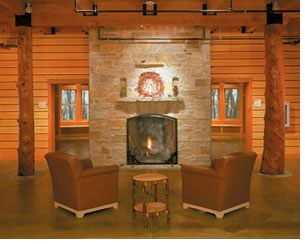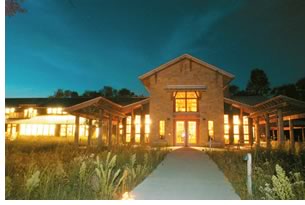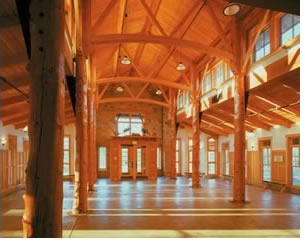

11/2004
 Milwaukee’s
Dorothy K. Vallier Environmental Learning Center at Schlitz Audubon Nature
Center, a design-build project by The Kubala Washatko Architects Inc.,
recently earned a Gold LEED™ (Leadership in Energy and Environmental
Design) certification from the U.S. Green Building Council. The 30,000-square-foot
learning center, which sits on 190 acres along the shores of Lake Michigan,
is the only new-construction Gold certified LEED building in Wisconsin
and one of just 28 gold-certified buildings in the U.S.
Milwaukee’s
Dorothy K. Vallier Environmental Learning Center at Schlitz Audubon Nature
Center, a design-build project by The Kubala Washatko Architects Inc.,
recently earned a Gold LEED™ (Leadership in Energy and Environmental
Design) certification from the U.S. Green Building Council. The 30,000-square-foot
learning center, which sits on 190 acres along the shores of Lake Michigan,
is the only new-construction Gold certified LEED building in Wisconsin
and one of just 28 gold-certified buildings in the U.S.
Appropriately, the privately funded, nonprofit center promotes environmental education and land stewardship. Each year more than 37,000 children experience nature through hands-on education programs. More than 70,000 people visit the center each year for learning, hiking, and connecting with nature. The client had decided in the center’s early planning stages six years ago that their new building would “walk the environmental talk.” They wanted to build the “greenest of the green” sustainable facility, despite the additional cost and challenge.
 Myriad green techniques
Myriad green techniques
Using LEED’s rating system as an environmental quality-control
yardstick, the client, architects, and contractor Jansen Group created
integrated sustainable building systems and processes into every aspect
of the building’s design and construction. The learning center
includes:
- A 10-kW photovoltaic power system (donated by We Energies) that supplies a significant portion of the building’s electricity
- Extensive use of natural light that reduces the energy needed for lighting
- Operable windows to facilitate natural ventilation
- Specially designed and placed window systems (donated in part by Johnson Controls)
- A geothermal heat system employing 90 groundwater wells to provide heating and cooling
- Low-flow plumbing and waterless urinals, which helps protect the environment by reducing water usage
- Pine logs harvested from environmentalist and author Aldo Leopold’s nature preserve in Sauk County, Wis., and donated by his family for use as external structural supports for the building’s front porch.
 The project also took advantage of other locally available building
materials and products to reduce the energy impact of transportation;
for instance, the architects opted for site-harvested lumber for the
timber frame and exterior decks. Thick wall construction allows greater
insulation and provides thermal mass to moderate indoor temperatures.
Additionally, the exposed concrete floor finish eliminates the use of
additional material.
The project also took advantage of other locally available building
materials and products to reduce the energy impact of transportation;
for instance, the architects opted for site-harvested lumber for the
timber frame and exterior decks. Thick wall construction allows greater
insulation and provides thermal mass to moderate indoor temperatures.
Additionally, the exposed concrete floor finish eliminates the use of
additional material.
According to Schlitz Audubon Nature Center Executive Director Elizabeth Cheek, the learning center’s construction process was an “environmental labor of love” that employed a wide range of earth-friendly building materials and techniques.
Copyright 2004 The American Institute of Architects.
All rights reserved. Home Page ![]()
![]()
 |
||
To learn
more, visit the learning center’s Web site.
|
||